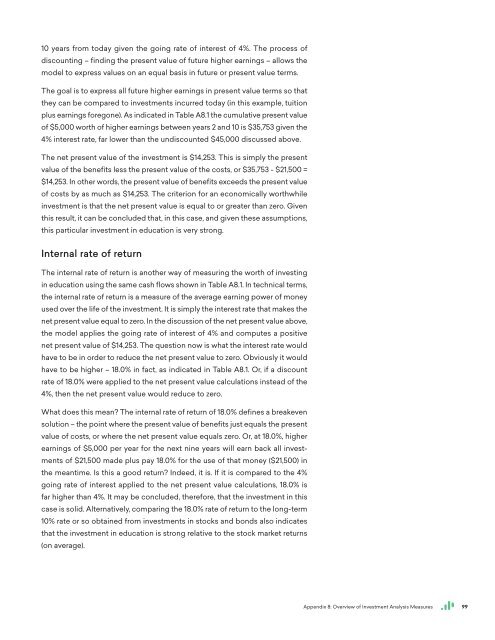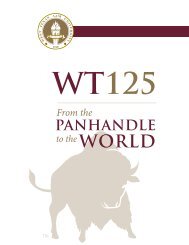The Economic Value of WTAMU Main Report
This report assesses the impact of West Texas A&M University (WTAMU) on the regional economy and the benefits generated by the university for students, taxpayers, and society. The results of this study show that WTAMU creates a positive net impact on the regional economy and generates a positive return on investment for students, taxpayers, and society.
This report assesses the impact of West Texas A&M University (WTAMU) on the regional economy and the benefits generated by the university for students, taxpayers, and society. The results of this study show that WTAMU creates a positive net impact on the regional economy and generates a positive return on investment for students, taxpayers, and society.
Create successful ePaper yourself
Turn your PDF publications into a flip-book with our unique Google optimized e-Paper software.
10 years from today given the going rate <strong>of</strong> interest <strong>of</strong> 4%. <strong>The</strong> process <strong>of</strong><br />
discounting – finding the present value <strong>of</strong> future higher earnings – allows the<br />
model to express values on an equal basis in future or present value terms.<br />
<strong>The</strong> goal is to express all future higher earnings in present value terms so that<br />
they can be compared to investments incurred today (in this example, tuition<br />
plus earnings foregone). As indicated in Table A8.1 the cumulative present value<br />
<strong>of</strong> $5,000 worth <strong>of</strong> higher earnings between years 2 and 10 is $35,753 given the<br />
4% interest rate, far lower than the undiscounted $45,000 discussed above.<br />
<strong>The</strong> net present value <strong>of</strong> the investment is $14,253. This is simply the present<br />
value <strong>of</strong> the benefits less the present value <strong>of</strong> the costs, or $35,753 - $21,500 =<br />
$14,253. In other words, the present value <strong>of</strong> benefits exceeds the present value<br />
<strong>of</strong> costs by as much as $14,253. <strong>The</strong> criterion for an economically worthwhile<br />
investment is that the net present value is equal to or greater than zero. Given<br />
this result, it can be concluded that, in this case, and given these assumptions,<br />
this particular investment in education is very strong.<br />
Internal rate <strong>of</strong> return<br />
<strong>The</strong> internal rate <strong>of</strong> return is another way <strong>of</strong> measuring the worth <strong>of</strong> investing<br />
in education using the same cash flows shown in Table A8.1. In technical terms,<br />
the internal rate <strong>of</strong> return is a measure <strong>of</strong> the average earning power <strong>of</strong> money<br />
used over the life <strong>of</strong> the investment. It is simply the interest rate that makes the<br />
net present value equal to zero. In the discussion <strong>of</strong> the net present value above,<br />
the model applies the going rate <strong>of</strong> interest <strong>of</strong> 4% and computes a positive<br />
net present value <strong>of</strong> $14,253. <strong>The</strong> question now is what the interest rate would<br />
have to be in order to reduce the net present value to zero. Obviously it would<br />
have to be higher – 18.0% in fact, as indicated in Table A8.1. Or, if a discount<br />
rate <strong>of</strong> 18.0% were applied to the net present value calculations instead <strong>of</strong> the<br />
4%, then the net present value would reduce to zero.<br />
What does this mean? <strong>The</strong> internal rate <strong>of</strong> return <strong>of</strong> 18.0% defines a breakeven<br />
solution – the point where the present value <strong>of</strong> benefits just equals the present<br />
value <strong>of</strong> costs, or where the net present value equals zero. Or, at 18.0%, higher<br />
earnings <strong>of</strong> $5,000 per year for the next nine years will earn back all investments<br />
<strong>of</strong> $21,500 made plus pay 18.0% for the use <strong>of</strong> that money ($21,500) in<br />
the meantime. Is this a good return? Indeed, it is. If it is compared to the 4%<br />
going rate <strong>of</strong> interest applied to the net present value calculations, 18.0% is<br />
far higher than 4%. It may be concluded, therefore, that the investment in this<br />
case is solid. Alternatively, comparing the 18.0% rate <strong>of</strong> return to the long-term<br />
10% rate or so obtained from investments in stocks and bonds also indicates<br />
that the investment in education is strong relative to the stock market returns<br />
(on average).<br />
Appendix 8: Overview <strong>of</strong> Investment Analysis Measures<br />
99





